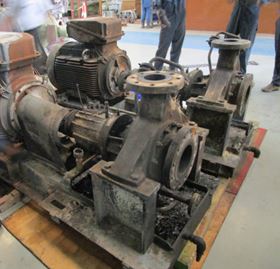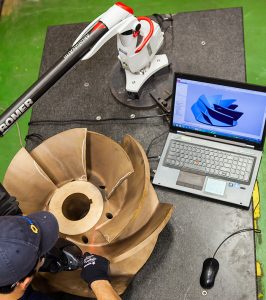Hydro Middle East, specialists in pump rebuilding, particularly in the oil and gas industry and other industrial markets was called in to assess the damage and redesign and rebuild the fire-damaged pumps. Hydro’s engineers first evaluate the causes of any pump damage or failure and then provide expert engineering analysis and a responsive field service.
Written by: Thomas Arakal (Hydro Middle East)
Published by: World Pumps

Two fire damaged pumps arrive at the Hydro Middle East Service Centre.
Analysis & recommendations
In the case of the fire-damaged pumps, once the fire was under control, Hydro immediately sent a field engineer to the site to conduct a root cause analysis and make recommendations to ensure that the equipment would be restored within the very fast turnaround that the company required.
The engineers discovered that the fire had been so severe it had completely burned out all of the oil in the bearing housing. In addition, the baseplate was also warped because of the excessive heat. A turnaround of between two and three weeks for redesign and rebuild was proposed, subject to mechanical seal availability and the two hot oil circulating pumps, along with the baseplate and the motors were shipped to Hydro Middle East’s facility in Dubai, U.A.E.







 The Problem
The Problem
